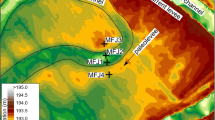Abstract
A zonation technique for sediment samples based upon contaminant ratios of a series of samples is described. The technique is based on the fact that sediment samples of common origin will tend to have similar ratios of concentrations of trace pollutants such as heavy metals, PCBs, etc., despite dilution by variable amounts of inert materials such as silica or calcite. Comparison of these ratios between individual samples yields a matrix of similarity coefficients, which are then analyzed by a hierarchical agglomerative cluster analysis procedure. Sediment samples of similar origin will tend to group together in a single cluster, whereas samples influence by unique factors such as transport patterns or proximity to point source discharges will appear as separate individual clusters. The results of application of this methodology to Great Lakes samples from Hamilton Harbour and Port Hope are presented.
Similar content being viewed by others
References
Anders, O. U.: 1972, ‘Ratio Matching — a Statistical Aid for Discovering Generic Relationships among Samples’, Anal. Chem. 44, 1930–1933.
Barica, J., Poulton, D. J., Kohli, B. and Charlton, M. N.: 1988, ‘Water Exhange between Lake Ontario and Hamilton Harbour: Water Quality Implications’, Water Pollution Res. J. of Canada, 23, 213–226.
Forstner, U.: 1980, ‘Trace Metal Analysis on Polluted Sediments. Part 1. Assessment of Sources and Intensities’, Env. Technol. Letters 1, 494–505.
Forstner, U. and Wittmann, G. T. W.: 1983, Metal Pollution in the Aquatic Environment. Springer-Verlag, New York, 486 pp.
Hart, D. R., McKee, P. M., Burt, A. J. and Goffin, M. J.: 1986, ‘Benthic Community and Sediment Quality Assessment of Port Hope Harbour, Lake Ontario’, J. Great Lakes Res. 12, 206–220.
IJC: 1988, Procedures for the Assessment of Contaminated Sediment Problems in the Great Lakes. Report of the Sediment Subcommittee and its Assessment Work Group to the Water Quality Board, International Joint Commission.
Ontario Ministry of the Environment: 1981, Hamilton Harbour Study 1977. Great Lakes Section, Water Resources Branch, Toronto, Ontario.
Ontario Ministry of the Environment: 1985, Hamilton Harbour Technical Summary and General Management Options. Great Lakes Section, Water Resources Branch, Toronto, Ontario.
Ontario Ministry of the Environment: 1988, Hamilton Harbour Remedial Action Plan. Unpublished draft summary report.
Persaud, D., Lomas, T. D. and Hayton, A.: 1987, The In-Place Pollutants Program. Volume III. Phase I studies. Aquatic Biology Section, Water Resources Branch, Ontario Ministry of the Environment, 94 pp.
Poulton, D. J.: 1987, ‘The Trace Contaminant Status of Hamilton Harbour’, J. Great Lakes Res. 13, 193–201.
Poulton, D. J., Simpson, K. J., Barton, D. R. and Lum, K. R.: 1988, ‘Trace Metals and Benthic Invertebrates in Sediments of Nearshore Lake Ontario at Hamilton Harbour’, J. Great Lakes Res. 14, 52–65.
Romesburg, H. C.: 1984, Cluster Analysis for Researchers. Lifetime Learning Publications, Belmont, California.
SPSS: 1988, SPSS/PC+Advanced Statistics V2.0, SPSS Inc., Chicago, Illinois.
Thomas, R. L.: 1972, ‘The Distribution of Mercury in the Sediments of Lake Ontario’, Can. J. Earth Sci. 9, 636–651.
Author information
Authors and Affiliations
Rights and permissions
About this article
Cite this article
Poulton, D.J. Statistical zonation of sediment samples using ratio matching and cluster analysis. Environ Monit Assess 13, 379–404 (1989). https://doi.org/10.1007/BF00394241
Issue Date:
DOI: https://doi.org/10.1007/BF00394241




